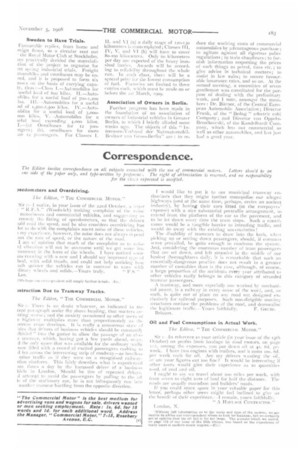Correspondence.
Page 17

If you've noticed an error in this article please click here to report it so we can fix it.
The Editor invites correspondence on ail subjects connected with the use of commercial motors. Letters should be on cue side of the pager only, and tyPe-written by Preferenc'. The right of abbreviation is reserved, and no responsibility for the views expressed is accepted.
peedometers and Overdriving.
The Editor, " THE COMMERCIAL MOTOR."
Sir :-I notice, in your issue of the aand October, a " R.1:..1." (Woolwich) making umiplaint of the noise motorbuses and commeecial vehicles, and sugge-,ine as remedy the fitting of speedometers, so that tht• drivers ;obi n-ad the speed, and he also considers ovc-rdriyinghas lot to do with the complaints anent noise of these vehidles. I my •xperieace, however, the noise does not always depend on the rate of speed, or the nature of the road.
I am n of opinion that much of the complaint is to noise -ed vibraiion will not he OVCVCOMC until we get sone jet-Men-lent in the form of the wheels_ I have noticed ,01114' ms reneing with a new and I should say improved iy-pe al heel, with solid treads, and could not help noticing how etch quieter the vehicles ran in contrast to vans with dinar\ wheels and solids.--Yours truly,
Lee.
{we sap,. i,, earl...spa:went will supply further details. -En., 3struction Due to Tramway Tracks.
rite Editor, " THE COMMERCIAL Mown."
Sir :-.hitere is im doubt whatever, as indicated in tIi,remit peragraph under the above heading, that nneters ,tting worse; and the anxiety occasioned to other users of
e highway multiplies more than proportionately ;ss die unwav craze develops. It is really a monstrous snes• 'airs that drivers of business vehicles should he consi mitt It ehlyied " into the gutter to allow the passage of an elee
c tramcar, which, having got a few yards ahead, skies,
d the only space that was available for the ordinary 1,reftie now filled with a crowd of excited passengers rushiras in d fro across the intervening strip of roadway—as heedless other traffic as if they were on a recognised railwayition platform. This fairly describes what is experienced any times a day by the harassed driver of a business bide in London. Should he tire of repeated. delays, d attempt to avoid the passengers by pulling to the oil le of the alationary car, he is not infrequently run into another tramcar hurtling from the opposite direction. I would like to put it to our municipal tramway enthusiasts that they might further monopolise our alleged highway, (and at the same time, perhaps, revive an ancient industry), by having their cars fitted (at the ratepayers. expens(-) with a nice substantial portcullis arrangement, to extend from the platform of the car LO the pavement, arid LO he let clown ever . time the tram stops. Such a contrivance would be a tangible barrier to intruding traffic, and wculd do away with "'the existing untertainties!
The disability of tramcars to draw into the kerb, Will-II ph-king up or setting down passengers, should, if common sense prevailed, he quite enough to condemn the system. And, considering the enormous number of train passengers that are set down, and left stranded in the middle of our busiest thoroughfares daily, it is remarkable that such au essentially-dangerous practice sloes not result in a greater number of casualties than is the case, although, of course, a large proportion of the accidents every year attributed to other vehicles really belongs to this category of stranded tramcar passengers.
A tramway, and more especially one worked by mechanical power, is a railway in every sense of the word, and, as such, is quite out of place on any road not designed exclusively for railroad purposes. Such non-dirigible moving structures confuse the problems of the road, and demoralise the legitimate traffic.Yours faithfully, F. GRunn. Brisson.
Oil and Fuel Consumptions in Actual Work.
The Editor, "Tun COMMERCIAL MOTOR."
Sir :-In reference to your article (in your issue of the tath October) on profits from haulage by road motors, on page 1;2, among the expenses, you put dea-n oil al 4s. 6d, lie, week. I have two engines with trailers, and it costs mos. 6d. per week each for oil. Are my drivers a misting the oil, or are your figures cut too fine? It would be interestingif other users would give their experience as to quantities used, of coal and oil.
ought to say we travel about aoo miles per week, with from seven to eight tons of-load for hull the distance. The roads are usually macadam and builders' roads.
If you could spare space. in your valuable paper for this letter, perhaps other users might feel inclined to give us the benefit of their experience.-l remain, voura faithfully, " A Hamann CONTRACTOR."
!potion, N.
!Without full information as to the make and type of the motors, we are unable to advise our eorpl.txwident where to look for leakages, but WM ePT tail)] y are of opinion that his oil bill is far too large. The amount which we stated, on page 11:2 of our issue of the 15th ultimo, was based on the experience of
many users oi modern Melina wagons.—Eml




















